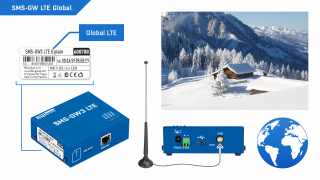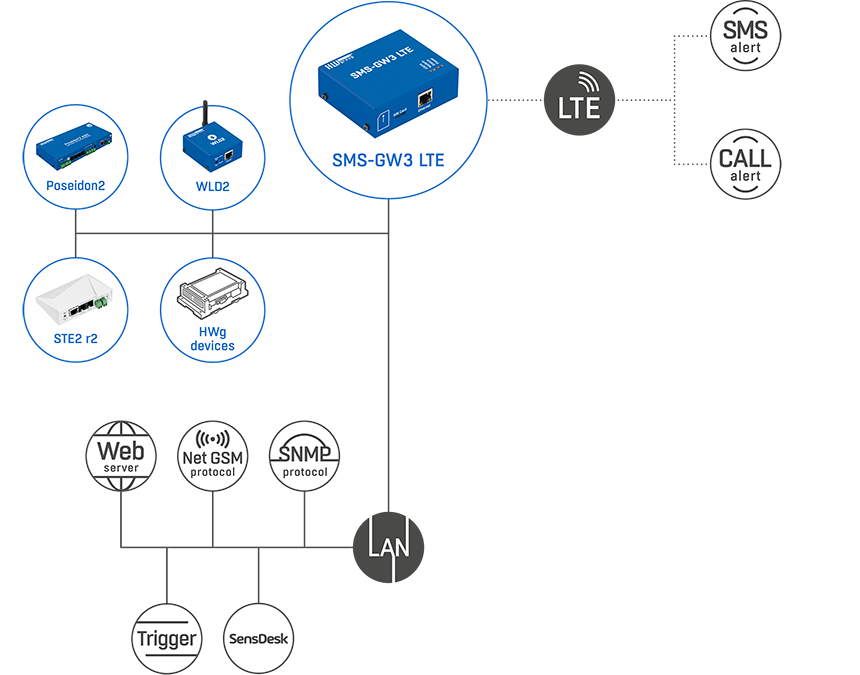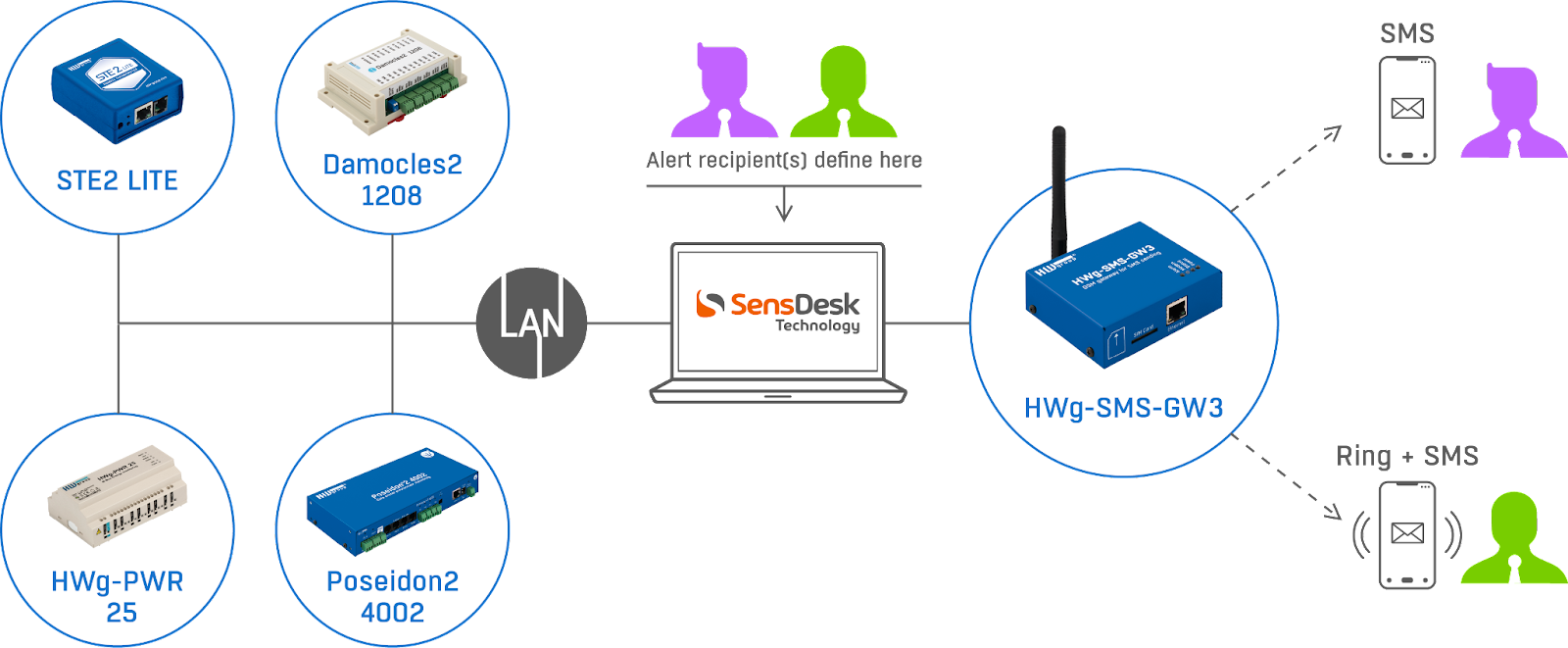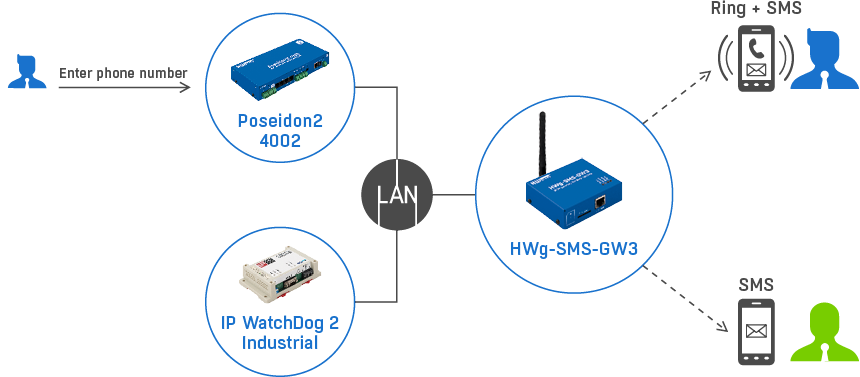SMS-GW as a part of the Ecosystem
Not only can it be useful in larger projects with dozens of devices and possibly hundreds of sensors to continuously monitor the environment and have all the alerts in place, but sometimes people simply prefer to get an SMS or phone call from the monitoring device instead of an email.
And we don't judge them - every setup is unique in how the remote site managers prefer to organize their monitoring and alerting in case something goes wrong. That's why HW group produces two versions of the SMS gateway, which we'll talk about in detail.

SMS-GW is a part of the RME (Remote Monitoring Ecosystem)
Delivering the SMS message or making a voice call alerting the customer if there is something wrong at the remote location is the final service HWg provides. And this alert should still work reliably five years from now, regardless of what is installed on the customer's phone. It is an easy to set up system, but reliable in the long run, which is one of the basic values for HW group.
All HW Group products can use SMS-GW for SMS and CallOut alerts. It's cheaper and easier to have a gateway with a SIM card in the company instead of relying on an independent SIM card with monthly fees in each monitoring device with connected sensors.

Both 2G (GSM) and LTE (nowadays it's probably not necessary to explain the difference between wireless broadband standards) SMS gateways, named SMS-GW3 as it is the third version of the gateway from our production, serve the same function - to send an alert in the form of a user/device-defined SMS message or to make a call-out alert - which is basically a call to a target phone number.
SMS-GW3 works seamlessly with all HWg products without any additional software. One SMS-GW3 on the same LAN could be accessible to multiple HWg devices in the company. It provides the SMS sending and CallOut (ringing) functions to several devices simultaneously and pushes alerts through the queue.
The SMS-GW3 device can also be used with the www.SensDesk.com and 3rd party service provider portals. The SensDesk Technology based portals can use SMS-GW3 LTE for alerting, as long as the gateway is accessible to the portal (either through a VPN or a public IP address) - all SMS and CallOut alerts could be handled by the gateway instead of the software Twilio service available to the portal's paid users (SensDesk.com or providers' portals).

However, both options (SMS-GW unit / SMS alerting from the Portal) have their limitations and advantages. Using gateway unit only can cause a situation, when the monitoring device is turned off (disconnected) - sending a critical alert message or making a call won't be available. So the combination with the Portal makes alerting even more reliable.
The following features are shared between the 2G and the LTE versions of the gateway:
- External antenna with a 3m cable
- Internal memory for outgoing SMS queue: 100 messages
- SMS/Calls GW for all HWg devices (RME)
- SMS/Calls GW for any SNMP software
- SMS/Calls GW for any NAGIOS (plugin by NETWAYS)
- Open API: SNMP, XML, netGSM (http, SOAP)
- Supports the "SMS + Ring" function for combined SMS and CallOut notification
- Mechanical: 76 x 93 x 28 mm, wall-mountable, fits on a DIN rail (optional)
Using SMS-GW from 3rd party SW/HW
3rd party devices (or software) can access the SMS-GW3 using one of three options:
- netGSM (SOAP - HTTP POST)
- HTTP GET
- SNMP Write (sending SMS from any SNMP software)
One of the most convenient features of the SMS-GW3 is that the SMS and CallOut alerts themselves are fully customizable within different monitoring devices that use the SMS-GW3 as a gateway - easy to connect to devices, especially within the HWg ecosystem of products.
One SMS-GW alerts several people

Therefore, there's no need to support several different configurations on the SMS-GW3 device itself - instead, everything is simply managed on different monitoring units with their sets of sensors responsible for monitoring environmental conditions.
In this way, a single SMS-GW3 can be used to send dozens of SMS or CallOut alerts to an unlimited number of recipients. If, in addition to the standard email alerting, you need a faster and, according to some, more reliable option, or just a slightly different means of delivering an alert - SMS-GW3 is here for you, supporting both the newer LTE and the older but still viable 2G.
Common question: Should I buy a cheaper 2G (GSM) or LTE version?The very old GSM (2G) standard started in the nineties and is still working in many countries, but most of the national regulators have already declared the date when the 2G GSM cellular network will be switched off. Switzerland will probably be the first European country to switch off its 2G coverage.
However, there are so many devices that depend on this network that it may take a decade for this to happen in your country.
Summary
Using a single hardware SMS-GW unit to send alerts (SMS/Call) from multiple LAN sensors in the enterprise makes the entire HWg monitoring system more robust & long-term reliable, even in a cost-effective and fully offline (without portal) version.













